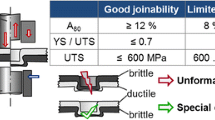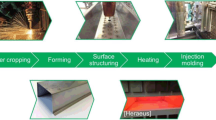Abstract
The combination of innovative materials, process chins and intelligent material-adapted design concepts enables an efficient part production for future mobility applications. Hybrid structures made of thermoplastic pre-impregnated composite (TPC) sheets and injection moulding bulk material have already crossed the threshold to series production. Thanks to a newly developed production technology, hollow profiles with continuous fibres can now also be integrated into thermoplastic composite hybrid structures in the sense of a modular design system. However, the resource consumption of such hybrid structures has not yet been investigated.
This contribution describes the set-up and life cycle analysis (LCA) of a highly automated manufacturing process for the production of complex crash-loaded vehicle structures in thermoplastic composite design. The concept bases on the production of a hollow profile made of hybrid yarn, which is subsequently overmoulded and combined with a TPC sheet in an injection moulding process. For the hollow profile manufacturing, a novel automated preforming technology is used. The textile preform is then consolidated in a variothermal consolidation station, consisting of a temperature control system and an additively manufactured consolidation tool. For the subsequent overmoulding of the hollow profile, methods for stabilising the hollow profile were studied and implemented in an injection moulding complex. A plasma system for activating the surface of the hollow profile was used to create a permanent joint between the hollow profile and TPC sheet. At the example of a backrest with an integrated seat belt, the technology and its potential application in crash-relevant structures was proven.
In addition to the process set-up, manufacturing studies were carried out with the aim of evaluating the ecological potential of the process chain. For this purpose, a cradle-to-gate approach was chosen, in which the process-related energy consumption as well as the material consumption were measured and used for LCA. Thus, the most relevant process steps can be identified and possibilities for increasing efficiency can be derived.
Access this chapter
Tax calculation will be finalised at checkout
Purchases are for personal use only
Similar content being viewed by others
References
Kaufmann, R., Bider, T., Bürkle, E.: Lightweight parts with a thermoplastic matrix. Kunstst. Int. 03, 65–68 (2011)
Kopp, J.W.: BMW I – automotive CFRP-production and potentials for thermoplastic FRP. In: Borgmann, F. (ed.) 2nd International Conference and Exhibition on Thermoplastic Composites ITHEC 2014, p. 11. Messe Bremen, Bremen (2014)
Götze, C.: From a Niche product to standard series production – highly resilient lightweight components produced from Organo sheet. Kunstst. Int. 03, 35–38 (2016)
Bernet, M., Bourban, M.: An impregnation model for the consolidation of thermoplastic composite made from commingled yarns. J. Compos. Mater. 08, 751–772 (1999)
Hufenbach, W., Adam, F., Krahl, M., Geller, S.: Ganzheitliche Lösungsstrategien bei der Entwicklung von Faserverbundkomponenten für automobile Leichtbauanwendungen. In: Kawalla, R. (ed.) 2nd International Conference on Advanced Metal Forming Processes in Automotive Industry AutoMetForm 2010, pp. 58–69. Institut für Metallformung, Freiberg (2010)
Küppers, S., Milwich, M., Gresser, G.T.: Energyefficient pultrusion process for producing fiber composite components with termoplastic matrix in series applications – Tpult. In: Hillmer, J. (ed.) 9th Aachen-Dresden International Textile Conference, p. 17. DWI – Leibniz-Institut für Interaktive Materialien e. V., Aachen (2015)
Gude, M., Lenz, F., Gruhl, A., Witschel, B., Ulbricht, A., Hufenbach, W.: Design and automated manufacturing of profiled composite driveshafts. Sci. Eng. Compos. Mater. 02, 187–197 (2015)
Masselter, T., Haushahn, T., Schwager, H., Milwich, M., Nathanson, R., Gude, M., Cichy, F., Hufenbach, W., Neinhuis, C., Speck, T.: Biomimetic fibre-reinforced composites inspired by branched plant stems. Design Nat. V, 411–420 (2015)
Braley, M., Dingeldein, M.: Advancements in braided materials technology. In: 46th International SAMPE-Symposium, pp. 2445–2455 (2005)
Liebsch, A., Kupfer, R., Defranceski, A., Rösler, B., Janik, J., Gude, M.: Automated preforming of braided hoses made of thermoplast-glass fiber hybrid yarns. Procedia CIRP 66, 57–61 (2017)
Schäfer, J., Gries, T.: Braiding pultrusion of thermoplastic composites. Advances in braiding technology – specialized techniques and applications. Woodhead Publishing Series in Textiles, pp. 405–428. (2016)
Engelmann, U., Layer, M., Albert, A., Reese, E., Landgrebe, D., Kroll, L., Nendel, W.: Towards the functionalized FRP tube – a merger of hydroforming and injection molding technologies is driving lightweight design. Kunstst. Int. 12, 11–14 (2017)
Landgrebe, D., Kräusel, V., Rautenstrauch, A., Awiszus, B., Boll, J., Markov, L.: Energy-efficiency and robustness in a hybrid process of hydroforming and polymer injection moulding. Proceedia Manufact. 08, 746–753 (2017)
Jelínek, P., Adámkov, E.: Lost cores for high-pressure die casting. Arch. Foundry Eng. 02, 101–104 (2014)
Jiang, W., Dong, J., Lou, L., Liu, M., Hu, Z.: Preparation and properties of a novel water soluble core material. J. Mater. Sci. Technol. 03, 270–275 (2010)
Michels, H., Bünck, M., Bührig-Polaczek, A.: Suitability of lost cores in rheocasting process. Trans. Nonferrous Met. Soc. China (English Edition) 20, 948–953 (2010)
Liebsch, A., Andricevic, N., Maass, J., Geuther, M., Adam, F., Hufenbach, W., Gude, M.: Battery mount in a hybrid design – a combination of fiber-reinforced thermoplastic and aluminum replaces a steel part. Kunstst. Int. 09, 46–49 (2015)
Pijpers, A.P., Meier, R.J.: Adhesion behaviour of polypropylenes after flame treatment determined by XPS(ESCA) spectral analysis. J. Electron Spectrosc. Relat. Phenom. 121, 299–313 (2001)
Tusek, L., Nitschke, M., Werner, C., Stana-Kleinschek, K., Ribitsch, V.: Surface characterisation of NH3 plasma treated polyamide 6 foils. Colloids Surf. A 195, 81–95 (2001)
Tahara, M., Cuong, N.K., Nakashima, Y.: Improvement in adhesion of polyethylene by glow-discharge plasma. Surf. Coat. Technol. 173–174, 826–830 (2003)
Oosterom, R., Ahmed, T.J., Poulis, J.A., Bersee, H.E.N.: Adhesion performance of UHMWPE after different surface modification techniques. Med. Eng. Phys. 28, 323–330 (2006)
Liebsch, A., Koshukow, W., Gebauer, J., Kupfer, R., Gude, M.: Overmoulding of consolidated fibre-reinforced thermoplastics – increasing the bonding strength by physical surface pre-treatments. Procedia CIRP 89, 209–214 (2019)
Hohmann, A., Albrecht, S., Lindner, J.P., Voringer, B., Wehner, D., Drechsler, K., Leistner, P.: Resource efficiency and environmental impact of fiber reinforced plastic processing technologies. Prod. Eng. Res. Devel. 12(3–4), 405–417 (2018)
Herrmann, C., Dewulf, W., Hauschild, M., Kaluza, A., Kara, S., Skerlos, S.: Life cycle engineering of lightweight structures. CIRP Ann. 67(2), 651–672 (2018)
Großmann, K., Wiemer, H., Großmann, K.K.: Methods for modelling and analysing process chains for supporting the development of new technologies. Procedia Mater. Sci. 2, 34–42 (2013)
Landgrebe, D., Kräusel, V., Rautenstrauch, A., Albert, A., Wertheim, R.: Energy-efficiency in a hybrid process of sheet metal forming and polymer injection moulding. Procedia CIRP 40, 109–114 (2016)
Brecher, C., Schmitt, R., Lindner, F., Peters, T., Emonts, M., Böckmann, M.G.: Increasing cost and eco efficiency for selective tape placement and forming by adaptive process design. Procedia CIRP 57, 769–774 (2016)
Beck, J., Kupfer, R., Hofmann, S., Liebsch, A., Gude, M.: Multi-Material-Design für die automobile Großserie - Faserverbund-Hohlprofile und Spritzgieß-Knotenstrukturen in einem Prozess. VDI-Bericht 2343: Plastics in Automotive Engineering PIAE EUROPE (2019)
Brandt, B., Kletzer, E., Pilz, H., Hadzhiyska, D., Seizov, P.: Silicon-chemistry carbon balance – an assessment of greenhouse gas emissions and reductions. CES – Silicones Eur. 05, (2012)
N.N. Environmental Product Declaration: Polyamide 6 (PA6). PlasticsEurope, Product Group Engineering Polymers 02, (2014)
Boustead, I.: Eco-profiles of the European plastics industry: glass filled polyamide 6. PlasticsEurope, product group engineering polymers 03, (2005)
N.N. Life cycle assessment of CFGF – Continuous Filament Glass Fibre Products. PwC – Sustainable Performance and Strategy, 10, (2016)
Stiller, H.: Material intensity of advanced composite materials – results of a study for the Verbundwerkstofflabor Bremen e. V. Wuppertal Papers Nr. 90 (1999)
Hohmann, A., Albrecht, S., Lindner, J.P., Wehner, D., Kugler, M., Prenzel, T., Pitschke, T., Seitz, M., Schüppel, D., Kreibe, T., von Reden, T.: Recommendations for resource efficient and environmentally responsible manufacturing of CFRP products. Carbon Composites e. V., Spitzencluster MAI Carbon (2017)
Müller, M., Liebsch, A., Kupfer, R., Stegelmann, M., Gude, M.: Process chain based data capture for a flexible and reliable life cycle inventory of a glass fiber-reinforced thermoplastic lightweight structure. Procedia CIRP 89, 32–36 (2019)
Delogu, M., Zanchi, L., Dattilo, C.A., Pierini, M.: Innovative composites and hybrid materials for electric vehicles lightweight design in a sustainability perspective. Mater. Today Commun. 13, 192–209 (2017)
Acknowledgements
The research projects are funded by the Federal Ministry of Education and Research (funding ref.: 02P14Z000_02P14Z010).
Author information
Authors and Affiliations
Corresponding author
Editor information
Editors and Affiliations
Rights and permissions
Copyright information
© 2021 The Author(s), under exclusive license to Springer-Verlag GmbH, DE, part of Springer Nature
About this paper
Cite this paper
Liebsch, A., Müller-Pabel, M., Kupfer, R., Gude, M. (2021). Life Cycle Assessment of Thermoplastic Hybrid Structures with Hollow Profiles. In: Dröder, K., Vietor, T. (eds) Technologies for economic and functional lightweight design. Zukunftstechnologien für den multifunktionalen Leichtbau. Springer Vieweg, Berlin, Heidelberg. https://doi.org/10.1007/978-3-662-62924-6_1
Download citation
DOI: https://doi.org/10.1007/978-3-662-62924-6_1
Published:
Publisher Name: Springer Vieweg, Berlin, Heidelberg
Print ISBN: 978-3-662-62923-9
Online ISBN: 978-3-662-62924-6
eBook Packages: EngineeringEngineering (R0)




